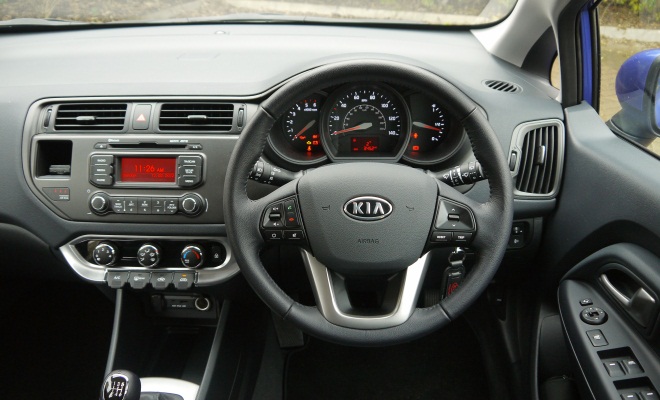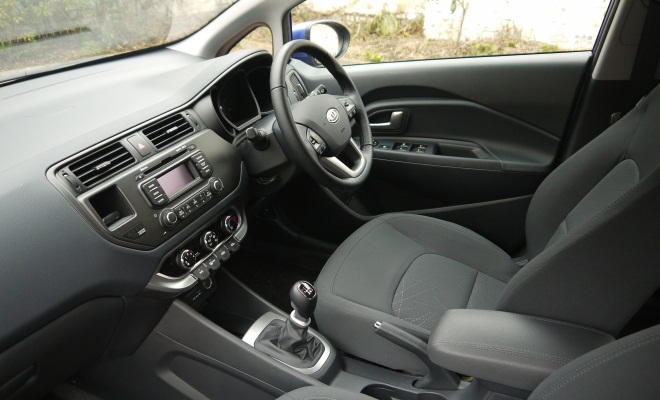
Half a decade ago, Kia lured German car designer Peter Schreyer away from the Volkswagen group, where he had delivered some outstandingly elegant and successful designs including the original Audi TT, first-generation A3 and mark-IV Golf.
Installed as global design chief at the Korean brand, Schreyer has since overseen a series of productions Kias which, while perhaps never quite as arresting as the TT, have been consistently attractive and interesting.
The latest Kia Rio small family car is a case in point. It looks sleek and low from the outside but feels airy and roomy inside, which is a neat trick to pull off.
But a great car needs depth as well as good looks, and I can’t help feeling that Kia needs to do some more poaching of key talent. Its headhunters definitely need to bring in some suspension expertise from somewhere, because I’ve yet to drive a modern Kia where ride quality wasn’t a weakness.

During a week of testing, involving lots of miles on London’s scabby streets, the Rio’s ride rarely felt better than jiggly and jittery. And while things were naturally smoother on faster roads, it would still thump clumsily over imperfections. The 16-inch alloys and 55-profile tyres of my test car can’t have helped. Smaller wheels with taller, squishier tyres would conspire to disguise many shortcomings in comfort. They might make a bit less of a drone on the motorway too.
I find myself dwelling on the ride because it’s so out of kilter with the remainder of the car, much of which is very good indeed. Interior design is largely on a par with the excellent exterior — fresh and yet refreshingly free of gimmicks.
I particularly liked the neat row of four switches at the bottom edge of the centre console, controlling the influx of fresh air, the aircon and the heated rear screen. It’s a dreadful cliché to say buttons fall easily to hand, but these toggles really do seem to fit the end of your fingertips, offering a pleasant piano-key action to boot. I also loved the clarity of the deeply hooded, triple-dial instruments.

I found plenty of welcome places to store things at the front, including an oblong recess ahead of the gearlever furnished with two 12-volt power sockets and an iPod connector.
Not every piece of the interior is quite so clever. Sit in the back and drop a coin into the deep well of the bottle bin in the door and you’ll never see it again, unless you possess hands as slender as a swan’s neck. Install a couple of kids back there and you’ll be forever fishing out treasured trinkets with a bent coat-hanger.
There is a surprising amount of room in the back — I had expected headroom to be limited but there’s actually plenty of space for ordinary adults with regular necks, arms and legs.
Returning to the pilot’s chair, I found the seat comfortable on a long slog around the M25. The roomy footwell includes a place to rest your clutch foot, which is always welcome on the motorway.

The six-speed manual gearbox fitted to my 1.1 CRDi EcoDynamics model offered up a clean and smooth action. The dashboard chipped in with slightly slow-witted suggestions as to the best moments to shift up and down, seemingly intent on keeping the engine spinning as close to 2,000rpm as possible. Sixth gear keeps the revs very low at motorway speeds, in aid of greatest economy, but does necessitate a visit to fifth when faced with even the most modest of uphill stretches.
The engine is a three-cylinder diesel capable of delivering a combined-cycle score of 88mpg and a remarkable 85g/km of CO2. To hit those figures, however, you must endure the Rio’s most hair-shirt spec. I tested the more mainstream “2” EcoDynamics edition, which includes alloys, aircon and other essentials, plus some nice-to-have features like a leather wheel and power folding mirrors. It returns a much worse CO2 score at 99g/km, no doubt largely due to those wide 16-inch wheels, but the figure is still good enough for a free tax disc and a congestion-charge waiver.
The little three-pot turbodiesel engine isn’t the most well-mannered companion I’ve ever spent time with. It might be frugal but it’s also rather throaty, and at tickover it seemed intent on shaking itself and the rest of the car to pieces. An excellent Bosch-built stop-start system provides welcome relief at the traffic lights, but it doesn’t always deliver. To ensure there’s sufficient power to start the engine once it’s stopped, the system won’t function unless the battery is warmer than 2°C. And I happened to test the Rio across a week of unrelentingly bitter weather, giving little opportunity for the stop-start function to spare me the shudders.
The 1120cc engine boasts a modern, variable-geometry turbocharger, boosting output to a relatively modest 74bhp and 170Nm of torque. This is sufficient to haul the car’s 1.2 tonnes to 60mph in a leisurely 15.5 seconds. Fortunately it doesn’t feel quite so slow on the road.
Official economy is 74.3mpg, whereas I saw the car’s own economy meter hovering around the 60mpg mark on faster journeys, and hitting the low-50s around town – the latter result would no doubt be better in temperatures warm enough for some stop-start action.
Base prices for the Rio run from £9,995, which gets you a petrol edition of the newly introduced three-door, through to £14,895 for the plushest 1.4-litre diesel five-door. The 85g/km EcoDynamics model costs from £11,895, while the five-door 2 EcoDynamics model I tested starts at £13,795, with the bright blue metallic paint adding £415.

And as a sticker in the rear window reminded me, the car comes with Kia’s seven-year, 100,000-mile warranty, just in case that engine does succeed in shaking something loose.
Peace of mind is a valuable extra, given that the Kia is not priced to dramatically undercut more established competition — indeed its asking price is pretty close to what you might shell out to own a Fiesta Econetic. Buyers likely to consider a Kia might also eye the Chevrolet Aveo Eco I tested last month, which is both brisker and a thousand pounds cheaper.
Good looks can only take you so far in life. If Kia could improve the ride, and smooth out the engine’s bad vibes, it would have a car fit to compete with the very best. For now, though, the Rio Eco is not quite as handsome a proposition as its looks might suggest.

Kia Rio review – 2012 EcoDynamics edition
15 February 2012
Read more about: fuel economy Kia test drives



